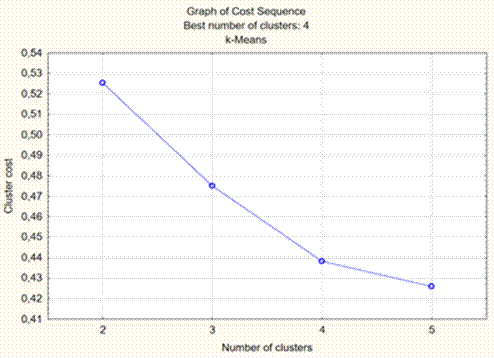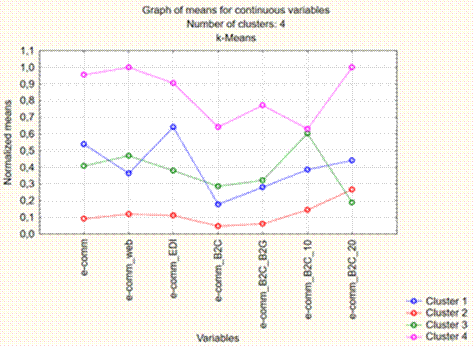INTRODUCTION
Risk and intensive progress of information and communication technology (ICT) provoked the appearance and development of a new trend as e-Commerce is. Including rapid ICT development, globalization is also one of the most important triggers for e-Commerce phenomenon expansion[1]. Applying ICTs as well as digital technologies to perform commerce activities in the Internet environment is a crucial characteristic of e-Commerce[1-3]. This phenomenon enters almost every sphere of business such as creating new products and/or services, advancing existing products and/or services, establishing communication with business partners and customers, promoting products and services on web locations, selling and distributing products around the world, etc.[4]. Different participants in businesses can be encompassed by mentioned changes caused by using e-Commerce. Therefore, this trend can also affect various established business models such as business-to-
-business (B2B), business-to-customers (B2C), business-to-government (B2G), customers-to-
-government (C2G), etc.[3]. Although e-Commerce generates many business benefits, using Internet possibilities to execute serious business activities can often be risky and untrustworthy for both sides in business transactions (supply-side and demand-side). Therefore, the quality of organized e-Commerce practices is one of the most critical factors for businesses hat want to establish or sustain successful performance in the e-Commerce market[5].
The expansion of e-Commerce removes spatio-temporal borders in the business world which consequently contributes to the agility and mobility of various enterprises in the global economy[2]. Therefore, many enterprises are deciding to invest more of their resources (financial, human, technological) in adopting some of the e-Commerce features in their business processes since they are aware of its benefits regarding business performance[6]. This intensified use of ICT and digital technology for performing activities within e-Commerce, at the business and personal level, undoubtedly contributes to digital economy growth ([7] according to[8]). Namely, e-Commerce represents a basis for establishing the digital economy[7] that is composed of social, demographic, competitive, and other changes in the global economy and society, caused by intensive digital technology use in all spheres of life[9]. Today, the importance of e-Commerce can be observed through the constantly growing number of businesses that are operating modern ways of doing business activities via the Internet and an assessment that only retail e-Commerce could globally reach about 4,1 trillion dollars this year[10]. European e-Commerce market generates 346,5 billion USD coming after the North American e-Commerce market with 552,6 billion USD and the Asian e-Commerce market as the leader in this market with achieved 831,7 billion USD ([10] according to[11]).
According to[12], e-Commerce has a strong impact on society and economy, especially in terms of increasing employment rates in different countries across the European Union, as well as enhancing the productivity level of employees in different enterprises. Bearing that in mind, many researchers are focusing on the e-Commerce practices adoption factors in small and medium enterprises as the key drivers of the national economy (e.g.[13-16]). Recognized e-Commerce significance for the economy is not a surprise, since this trend transforms the way of conducting traditional business transactions, making them available 24/7, not making any losses due to time difference to enterprises that offer products/services via the Internet worldwide, as well as saving customers’ time and cost in the same time. Since e-Commerce has a strong impact on the economy worldwide, as well as in European countries, it is important to investigate e-Commerce practices that mostly generate total turnover within enterprises. Therefore, this article has scientific and practical contributions. Firstly, it provides all European but also worldwide practitioners with insight into which e-Commerce practices engender the highest profit for enterprises. Secondly, the results of this article enable researchers and practitioners to understand the difference, in the context of digitalization and e-Commerce advancement, between developed and developing European countries. Thirdly, this article fills the gap in the still scarce existing literature that investigates the quality of e-Commerce practices in European countries.
In this article, the authors investigated differences among European countries according to
e-Commerce practices, such as enterprises’ total turnover from e-Commerce and web sales focusing on B2C, B2B, and B2G clients. Used datasets are available at Eurostat for enterprises in the year 2018. Statistical measures included descriptive and hierarchical cluster analysis. Findings showed that there is digital divide among European countries. At the level of European Union, policies, procedures and strategies should be done to reduce digital divide and to encourage economies and societies to use ICTs more to gain competitive advantage.
The article is arranged into six parts. In the Introduction part, e-Commerce as one of the drivers of economic development is emphasized. Also, the quality of e-Commerce practices has been recognized in the Introduction part. The goal of the article and methodology are shortly described in the Introduction part also. In the Literature review part, the main issues of the article are presented: impacts of the e-Commerce on economy and development of ICTs as a prerequisite for e-Commerce usage. Data and statistical analysis are defined in the methodology part. Definitions of the variables for the descriptive and hierarchical cluster analysis are explained also in the methodology part of this article The results of the descriptive and hierarchical cluster analysis of different levels of e-Commerce practices among selected European countries are presented in the Results part. Given results are explained in the Discussion part. The concluding remarks of the article and compares with similar research are given in the conclusion part. Furthermore, the Conclusion part presents the practical implications of the results, future research steps, and the limitations of the article.
LITERATURE REVIEW
E-COMMERCE AND ICT
E-Commerce represents a topic that has been in the focus of researchers for many years, which is not astonishing since e-Commerce activities provide a foundation for the recent generation of doing business in a digital form. According to[17], the phenomenon of
e-Commerce is the best indicator that points out how our lives are transforming digitally, including changes on personal, organizational, and global levels. Therefore, for developing the digital economy in a country, it is critical to ensure its support by using well-organized and effective e-Commerce practices[18]. The e-Commerce trend represents new business models comprising different commercial activities conducted through wireless networks, ICT, digital technologies, and Web 2,0 technologies[19-21]. Recently, up-to-date technologies as artificial intelligence (AI) -based technologies, business intelligence application and technologies for big data analysis are becoming the key technological backbone for various businesses operating in the e-Commerce market[22]. In addition to AI and Big Data technology, contemporary trends of e-Commerce focus on various e-Commerce activities (e.g. online marketing, ordering, selling, buying, paying, and distributing) that are conducted using social media, smartphones, promoting videos, webchats, pop-ups, etc.[23]. Owing to the above-mentioned technologies and Internet possibilities, e-Commerce enables buyers and sellers to carry out commerce-related business transactions without direct physical contact[20, 23].
CHARACTERISTICS AND QUALITY OF E-COMMERCE
Considering how participants act within business models, e-Commerce divides into two parts: e-Commerce sales and e-Commerce purchases[24]. During the sale process, participants can place business orders via websites or electronic data interchange (EDI). Hence, e-Commerce sales consist of two main methods: “web sales” and “EDI-type sales”[24]. E-Commerce methods such as buying and selling products and services via websites or EDI[24, 25] mostly encompass business models like B2B, B2C, B2G, customer-to-customer (C2C), C2G, etc.[3]. Still, the two most important forms of e-Commerce are (i) B2B in which enterprises are executing their businesses via electronic networks with their partners and (ii) B2C in which enterprises are selling goods/services to their customers[26]. Apart from individuals and enterprises, governments are also part of the e-Commerce community[27]. Therefore, altogether with B2B and B2C models, it is substantial to observe the B2G model as an equally important business model in which the government participates as a buyer and enterprise as a seller[27]. In this way, individuals as participants in e-Commerce practices are achieving many benefits as (i) saving time needed for physically going to the store (ii) selling and using services from their own home, (iii) buying and selling products available all around the world, (iv) promoting their products or services worldwide, (v) saving money by using lower web-shop prices of products, etc. On the other hand, using e-Commerce practices enables enterprises to (i) timely predict and understand clients’ needs and requirements,
(ii) promptly fulfil personalized customers’ orders, (iii) effectively execute business processes, (iv) diminish costs, (v) increase profits, etc.[22, 28]. Through e-Commerce practices, governments and enterprises within B2G model are also gaining benefits such as (i) reduced paperwork, (ii) reduced time for additional administrative work, (iii) reduced additional costs,
(iv) easier and quicker access to legal, financial and tax demands from the business side,
(v) increased quality level of products and services, (vi) new ways developed for off ering and selling goods and services, etc.[27]. To achieve the mentioned benefits of applying
e-Commerce practices in different business models, it is important to ensure that they are of sufficient quality. According to[27], the quality of e-Commerce is mainly focused on
i) quality of web sites content, ii) quality of technology in charge of timely business transactions execution worldwide, iii) quality of ancillary services of the transactions performed, iv) quality of security methods, and v) quality of e-Commerce community support.
E-COMMERCE DEVELOPMENT AND SIGNIFICANCE FOR THE ECONOMY
The development of e-Commerce begins in the 70s and 80s of the last century with using EDI between enterprises, enabling them to conduct business transactions in the context of exchanging business information and documents, also including funds for executing electronic payments[26, 29] according to[30]. With ICT and Internet progress, the real process of growth and advancement of the e-Commerce phenomenon started in the mid-90s and arose through the following four phases[31, 32]. The first phase was focused on using Internet possibilities to share information about goods/services[31, 32]. In the second phase, everything was about World Wide Web usage to obtain customers’ orders and distribute information about the use of goods/services[31, 32]. Utilizing ICT technologies to deliver goods/services in a digital forms, was present in the third phase[31, 32]. In the current fourth phase, the focus is on the appearance of Web 2,0 technologies, 3G and 4G networks enables faster and easier communication between participants on demand-side and supply-side[31, 32]. Today, the most popular trends of e-Commerce practices are animations included in promoting activities, online sales, and marketing activities. Mentioned activities involve business process automation, AI technologies as chatbots on websites, and 360° images/videos[33]. The aforementioned technology advancement is constantly encouraged by the progress of e-Commerce, which is, on the other hand, developing parallelly with the growth of the digital economy[31]. Therefore, it can be concluded that the same as the digital economy is changing the society and economy we know, also does
e-Commerce. E-Commerce is especially important in the time of social distancing caused by today’s COVID-19 pandemic. According to[34], people are spending 10-30 % more on online shopping in the last 3 months than usual[35], particularly on buying essential household goods, groceries, baby products, as well as medical and cleaning products[36].
E-COMMERCE IN EUROPEAN UNION
Despite the global crisis in 2020 and the consequently increased use of web sales in the whole world, European countries are generally more engaged in digital activities in the last several years[37]. According to the “Digital Economy and Society Index” (DESI) that includes digital execution and follows digital competitive advantage of countries within the EU, Finland, Sweden, the Netherlands, and Denmark are ranked in the highest positions according to the results for 2019[37]. They are followed by the United Kingdom, Luxembourg, Ireland, Estonia, and Belgium[37]. Among the other indicators, the DESI index also investigates the integration of digital technology in the European countries, therefore including business digitization and e-Commerce[37]. E-Commerce index investigates the rate of SMEs included in web sales, SMEs’ turnover achieved by using e-Commerce practices and the rate of SMEs using web sales worldwide[38]. According to all three indicators within e-Commerce, Ireland, Belgium, and Czechia are reaching the highest results in 2019[38]. Sweden and Denmark also reveal admirable results according to some of the indicators within the e-Commerce index[38]. For instance, Denmark is achieving the most notable results concerning the number of enterprises included in web sales in 2019[38]. In developing countries as Bulgaria, Romania, Latvia, and Greece, e-Commerce index is still very low[38]. Comparing the e-Commerce index with the business digitization index (percentage of social media, electronic information sharing, big data analysis, and cloud technologies usage), enterprises in Bulgaria, Romania, Latvia, and Greece are acquiring higher results in using digital technologies in businesses than realizing e-Commerce activities[38]. Therefore, it can be concluded that developing countries are also interested in using digital opportunities in their businesses but they still have to additionally explore, understand, and finally use conveniences that e-Commerce can offer to them.
PREVIOUS RESEARCH ON E-COMMERCE PRACTICES QUALITY IN ENTERPRISES
Regarding emphasized importance of e-Commerce in today’s economy and society, many authors are examining this topic on the enterprises of all sizes in various countries. Therefore, the authors[39] investigated the significance of the e-Commerce practices quality on perceived risk, value, loyalty, and satisfaction of customers. Accordingly, the results of their study show how enterprises can achieve higher revenues and competitive advantage by investing in e-Commerce quality (especially in websites for web sales) that positively influence customer loyalty, satisfaction, and perceived value[39]. Given its many opportunities for businesses, e-Commerce practices are increasingly replacing or complementing traditional procedures of buying and selling products/services[40]. Hence, many researchers are investigating the turnover shares of e-Commerce methods in the total turnover of enterprises within different countries. Bearing that in mind, authors [24] researched the turnover of e-Commerce in European countries during 2009 and 2010. According to their results, EDI-type sales occupied a higher rate in total turnover within mostly observed countries in EU27 during 2010, while Lithuania, Latvia, Greece, Bulgaria, and Cyprus achieved a higher percentage of using web sales in total turnover[24]. Similarly,[41] investigates B2C e-Commerce turnover in European countries in her study, which results indicate that developed countries like Ireland and the UK are more involved in e-Commerce activities. On the other hand, developing countries like Romania, Bulgaria, Greece, Italy, and Cyprus are still lagging with a lower rank of total participants engaged in B2C e-Commerce practices. Commonly, online processes and procedures in many industries worldwide have a strong impact on increasing their sales turnover. For example, authors[42] concluded that online rental activities have a positive impact on car rental services in the Indonesian city of Medan. Likewise, authors[43] found out that online sales offer also influence increasing sales turnover in the airline industry in Nigeria. Digital opportunities as mobile and Internet banking were also positively experienced in the financial sector in Italy ([44] according to[45]). Except for the private sector, also the public sector encountered the benefits of online procedures and digital technologies involved in operating business processes. Accordingly, using the Internet and digital technologies in public services, established e-government improves public services giving the citizens broader authority to involve in public services due to simultaneously improved administration businesses, social value, and reduced cost[46].
As it is shown with relevant literature on this topic, e-Commerce practices, as well as their quality, have a positive impact on enterprises as well as on the economy and society in the whole world. Enterprises worldwide are mostly focused on using websites, or EDI technology to promote, sell, or purchase and distribute their products and services. Therefore, in the following section, the significance and positive characteristics of two main e-Commerce methods (web sales and EDI-type sales) on enterprises in European countries will be further analysed.
METHODOLOGY
DATA
Seven variables used in the analysis are collected from the European Commission statistical database – Eurostat (Table 1) and refer to enterprises’ turnover from e-Commerce and web sales with different clients: B2C, B2G, and B2B. Data are collected for the year 2018 for 29 European countries.
Selected variables refer to enterprises’ total turnover from e-Commerce, from web sales and from EDI-type sales as well as from web sales according to business with other business partners and government. Countries for which data are not available are excluded from the analysis. E-commerce implicit sales of products or services via Internet. E-sales refers to sales via websites or apps (web sales) or in an automated way via EDI (electronic data interchange) type messages.
STATISTICAL ANALYSIS
Data regarding e-Commerce practice in European countries are collected from the European database[47]. We used seven variables regarding e-Commerce practice among enterprises without the financial sector and with 10 persons employed and more, for the year 2018. Statistical measures like mean, minimum, maximum, and standard deviation are used to present data together with column graphs. Descriptive analysis was used to graphically present collected data about e-Commerce practices for 29 European countries for the year 2018. Hierarchical cluster analysis was used to identify homogenous groups of selected variables and to investigate different level among European countries regarding e-Commerce usage. Given results are presented using a graph of the cost sequence, ANOVA analysis, and cluster means. In addition, the graph of cost sequence presenting the error function for the various number of clusters was used (Figure 5) in order to define the optimal number of clusters which is four.
RESULTS
RESULTS OF DESCRIPTIVE ANALYSIS
Table 2 presents descriptive statistics of enterprises’ turnover from e-Commerce and web sale, for the year 2018.
The highest mean values have following two variables: Enterprises’ total turnover from e-Commerce (e-Comm: 16,34) and Turnover of the enterprises where web sales are more than 1 % of total turnover and B2C web sales more than 10 % of the web sales (e-Comm_B2C_10: 13,69). Other variables have lower mean values. It can be concluded that regarding e-Commerce activities, enterprises are mostly focused on sales of products or services via Internet.
Figure 1 presents enterprises’ total turnover from e-Commerce in percentage for all enterprises, without financial sector, with 10 persons employed or more. Enterprises from only two countries have more than 30 % of total turnover from e-Commerce (Belgium: 32 % and Ireland: 35 %). In developing countries there is lower percentage of enterprises’ total turnover
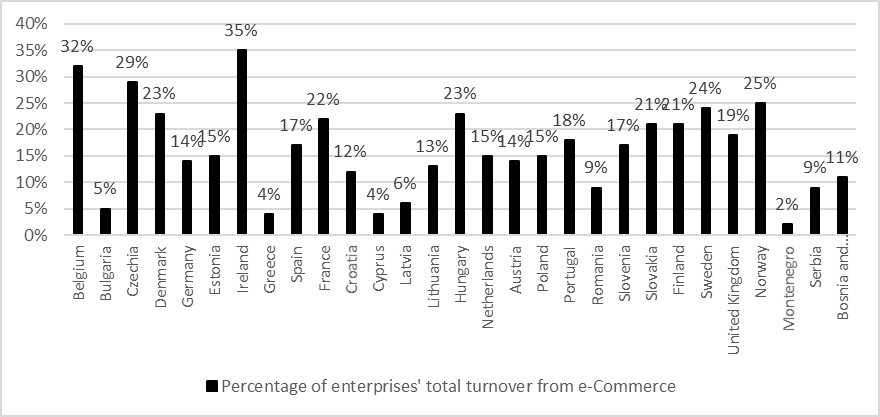
from e-Commerce (Montenegro: 2 %; Cyprus: 4 %; Greece: 4 %; Bulgaria: 5 %; Latvia: 6 %; Romania and Serbia: 9 %). It can be noticed that digital divide among European countries exists in the area of e-Commerce.
Data regarding enterprises’ total turnover from web sales and EDI-type sales in percentage for all enterprises, without financial sector, with 10 persons employed or more are presented in Figure 2. The greater difference among enterprises’ total turnover from web sales and EDI-type sales is in Czechia and Slovenia. In addition, there is quite higher percentage of enterprises’ turnover from EDI-type sales compared to turnover from web sales. In most of the other selected European countries the situation is quite similar with lower difference among two mentioned variables and their values. The exception is Greece where there are no enterprises with total turnover from EDI-type sales. In Cyprus, Lithuania, Serbia and Bosnia and Herzegovina, there is higher percentage of enterprises’ total turnover from web sales than from EDI-type sales.
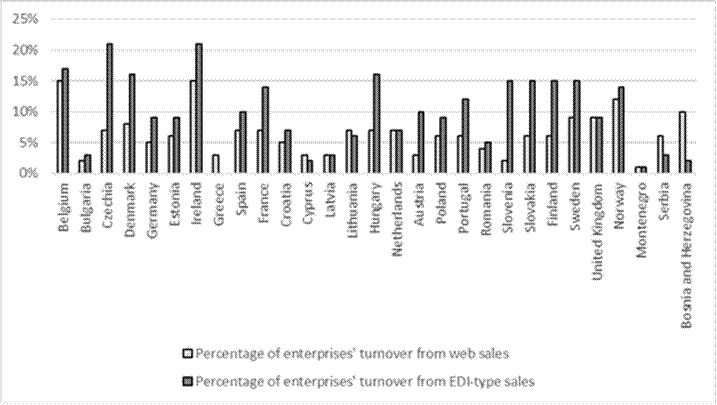
Percentage of enterprises’ turnover from web sales – B2C, and turnover from web sale – B2B and B2G for all enterprises, without financial sector, with 10 persons employed or more are presented in Figure 3. The greater difference among enterprises’ turnover from web sales – B2C and turnover from web sales – B2B and B2G is in Belgium. In addition, there is quite higher percentage of enterprises’ turnover from web sales – B2B and B2G compared to turnover from web sales – B2C. In most of the other selected European countries there is almost the same percentage of enterprises’ total turnover from web sales – B2C, and from web sales – B2B and B2G. In Ireland and the United Kingdom, the situation is vice versa; enterprises’ total turnover from web sales – B2C is higher that enterprises’ total turnover from web sales – B2B and B2G.
Collected data regarding enterprises’ turnover where web sales are more than 1 % of total turnover and B2C web sales more than 10 % of the web sales and where web sales via an
e-Commerce marketplace are at least 20 % of the web sales for all enterprises, without financial sector, with 10 persons employed or more are graphically presented in Figure 4. The
greater difference among enterprises’ total turnover where web sales are more than 1 % of total turnover and B2C web sales more than 10 % of the web sales and where web sales via an e-Commerce marketplace are at least 20 % of the web sales for all enterprises is in Croatia,
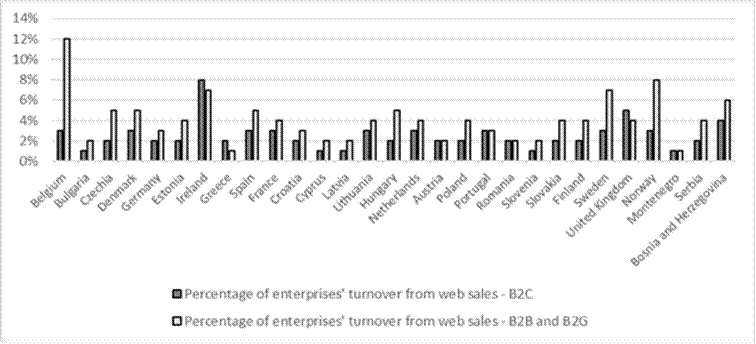
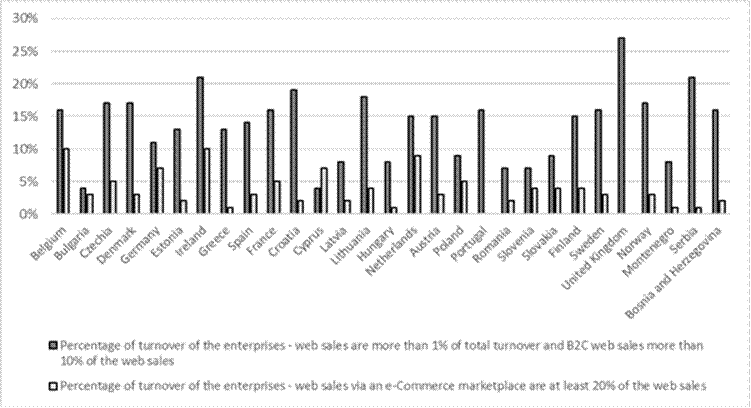
Lithuania, Norway, Serbia, Bosnia and Herzegovina. In addition, there is quite higher percentage of enterprises’ total turnover where web sales are more than 1 % of total turnover and B2C web sales more than 10 % of the web sales compared to turnover from web sales via an
e-Commerce marketplace are at least 20 % of the web sales in above mentioned countries. In Portugal and the United Kingdom there are only enterprises with total turnover where web sales are more than 1 % of total turnover and B2C web sales more than 10 % of the web sales.
RESULTS OF CLUSTER ANALYSIS
ANOVA analysis test (Table 3), cluster means values (Table 4) and graph of cost sequence (Figure 5) are conducted and present results for hierarchical cluster analysis.
Figure 5 defines the graph of cost sequence presenting the error function for the various number of clusters (Figure 6) in order to define the optimal number of clusters, which is in this case four clusters.
***statistically significant at 1 %
Results for ANOVA analysis and k-means clustering for seven variables which are grouped into 4 clusters are presented in Table 3. Selected data refers to e-Commerce usage in the year 2018 for 29 European countries. All selected variables are statistically significant at 1 % which implies that solution of using four clusters is justified.
Mean values for each of four clusters according to seven variables are presented in Table 4. The highest mean values for all seven variables are for Cluster 4 where are grouped Belgium and Ireland. However, comparing all seven variables, the highest mean value has variable Enterprises’ total turnover from e-Commerce for Cluster 4 (33,50). The lowest mean values for all seven variables are in Cluster 2, especially for variable Enterprises’ turnover from web sales – B2C (1,33).
DISCUSSION
Table 5 presents countries across clusters. In Cluster 1 there are following countries: Czechia, Denmark, Germany, France, Hungary, Netherlands, Austria, Poland, Slovenia, Slovakia, Finland, and Sweden. Cluster 2 consists of: Bulgaria, Greece, Cyprus, Latvia, Romania, and Montenegro. Estonia, Spain, Croatia, Lithuania, Portugal, the United Kingdom, Norway, Serbia, Bosnia and Herzegovina are part of Cluster 3. In Cluster 4 are grouped Belgium and Ireland. The less developed European countries, in the context of digitalization and
e-Commerce advancement, are grouped into Cluster 2 and they have the lowest mean values for all seven variables in the area of e-Commerce. There is the lowest percentage of enterprises’ turnover from web sales and e-Commerce. Some of the possible reasons that influence on low usage of e-Commerce could be: employees with low digital skills, high cost of ICTs usage, and low level of ICTs infrastructure.
Countries grouped into Cluster 1 and Cluster 3 have quite similar mean values. Enterprises grouped into Cluster 1 and Cluster 3 should try to use more benefits from e-Commerce and to improve their business using latest advances in the area of the ICTs. Belgium and Ireland are leaders in the area of e-Commerce. Enterprises from Belgium and Ireland have the highest
percentage of turnover from web sales an e-Commerce. In addition, Belgium and Ireland are quite high ranked regarding ICTs usage and development, which has positive impact on their social and economic development.
Figure 6 presents graph of the cluster normalized means, where it is showed that Cluster 4 (Belgium and Ireland) has the highest mean values for all selected variables regarding e-Commerce usage.
CONCLUSION
In this article, data regarding e-Commerce practice in European countries are presented aiming to investigate are there any significant differences among selected European countries. Therefore, the authors conducted descriptive statistics methods and cluster analysis and classified 29 observed countries into 4 clusters due to given distinctions among the countries according to 7 analysed variables on e-Commerce usage. Final results show how enterprises from developing countries like Bulgaria, Greece, Cyprus, Latvia, Romania, and Montenegro reach the lowest percentage of turnover from web sales and e-Commerce. On the other hand, results present that enterprises from western European countries such as Belgium and Ireland have a leading position considering turnover from web sales and e-commerce practices. They are also the highest positioned countries in the field of e-Commerce as well as in the usage and development of ICT that consequently had a positive influence on their economy and society. Accordingly, it can be concluded that enterprises from countries which lag behind regarding ICT development, less employ e-Commerce practices with lower quality standards than enterprises within western European countries. Therefore, it is apparent that the significant difference between the selected European countries regarding the usage and quality of web sales and e-Commerce practices exists.
Results obtained from this analysis confirm previous research on the same topic and for the same sample in 2010 in which the same countries were lagging in e-Commerce practices usage. Similarly, some previously conducted research shows that countries that are leaders in ICT sector, such as Ireland, the United Kingdom, Sweden, the Netherlands, Denmark, Germany, Finland, and Belgium utilize more B2C e-Commerce than other European countries like Bulgaria, Romania, Italy, Cyprus, Greece, Hungary, Latvia.
Therefore, this study can be particularly important for developing countries considering the results of the research that are pointing to e-Commerce effects on the development of economies. Likewise, previously published literature on this topic points to how e-Commerce can have a strong impact on society and the economy of different countries. Accordingly, evolved awareness of ICT and e-Commerce usage importance in various national business models can contribute to the social and economic prosperity of developing countries.
Based on the results of this research as well as relevant scientific researches on this field, the following conclusions can be made. It is noted that the untapped potential of using e-Commerce activities on the supply side and unrealized benefits of e-Commerce practices on the demand side is still present in most of the European countries. Hence, European Commission should focus more on how to make it easier for developing European countries to adopt and implement advanced ICTs and digital technologies in businesses and initiate effective use of e-Commerce practices within different business models. The limitations of this article come out of the fact that potential drivers or constraints by which some countries successfully (not)employ e-Commerce opportunities are unconsidered. Consequently, the recommendation for future research is to investigate the technological, organizational, and environmental factors that could be potential initiators of ICT, digital technology, and e-Commerce practice usage on the national or enterprise level in different countries.

